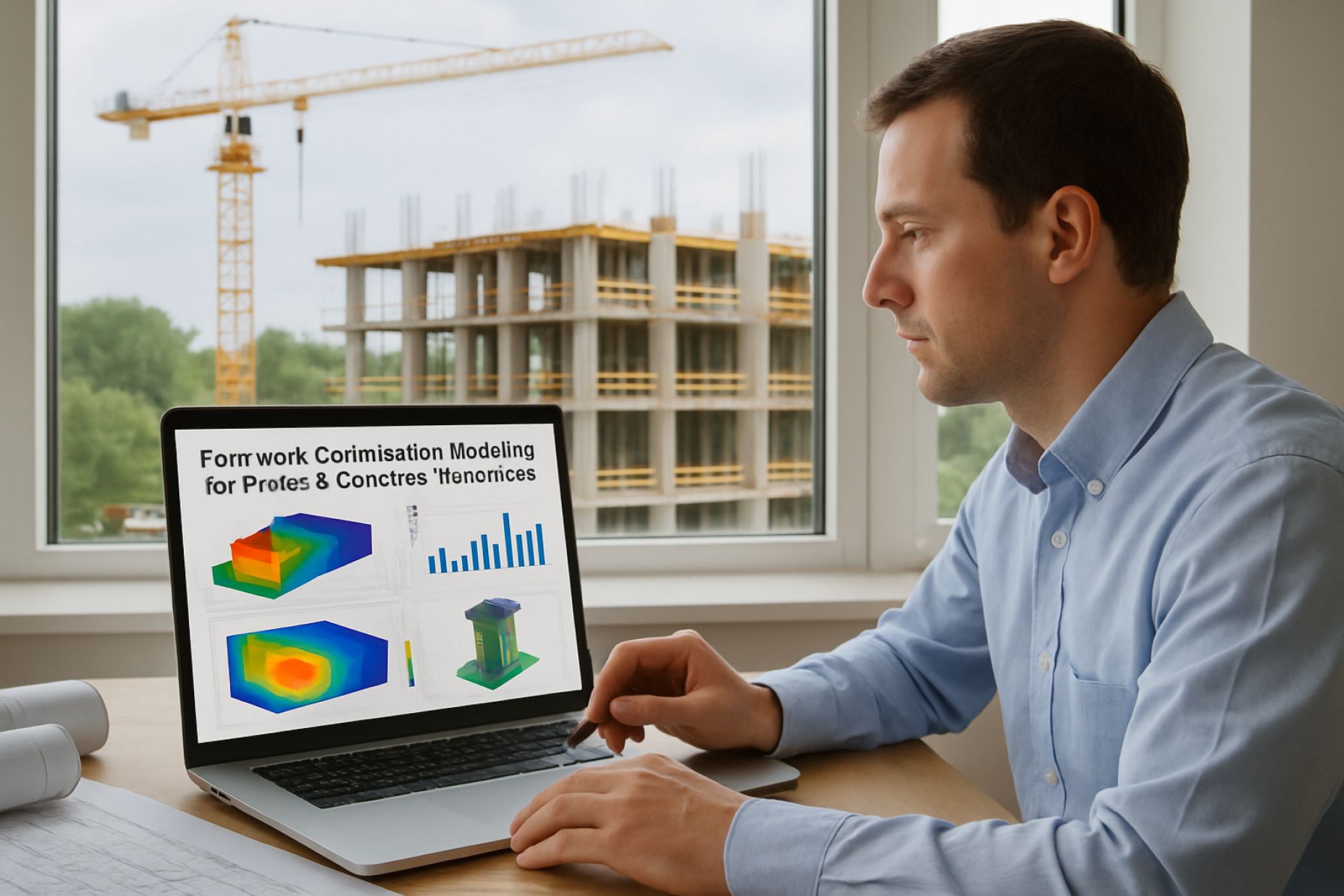Table of Contents
- Executive Summary and Key Findings
- Market Size and Growth Forecast (2025–2030)
- Technological Advancements in Formwork Optimization Modeling
- Adoption Trends in Precast Concrete Construction
- Digital Twin and BIM Integration for Formwork Optimization
- Sustainability and Environmental Impact Considerations
- Competitive Landscape: Leading Companies and Innovations
- Regulatory Standards and Industry Guidelines
- Key Challenges and Risk Mitigation Strategies
- Future Outlook and Strategic Recommendations
- Sources & References
Executive Summary and Key Findings
The construction industry in 2025 is witnessing a significant shift towards digitalization and efficiency, with formwork optimization modeling for precast concrete structures emerging as a critical focus area. Global infrastructure expansion, urbanization, and the rising demand for sustainable construction solutions have accelerated the adoption of advanced modeling and digital twin technologies for precast concrete formwork. These innovations are enabling contractors, designers, and manufacturers to enhance productivity, safety, and material usage while reducing labor costs and project durations.
Key industry players are integrating Building Information Modeling (BIM) and parametric design tools to streamline formwork planning and execution. For example, www.doka.com and www.peri.com, leading formwork and scaffolding companies, have expanded their digital solution offerings, providing platforms that allow for virtual planning, clash detection, and the optimization of resource allocation. These platforms enable the simulation of various formwork systems, helping to determine the most efficient configuration based on project-specific parameters.
In 2024 and into 2025, there is a notable emphasis on the integration of automation and robotics in precast formwork processes. Manufacturers such as www.elematic.com have introduced automated machinery for both formwork assembly and concrete casting, enabling more precise and repeatable operations. These advances are reducing human error, minimizing waste, and supporting just-in-time manufacturing practices.
Sustainability remains a driving factor, with formwork optimization modeling contributing to reduced material usage and lower carbon footprints. Efforts by organizations like the www.pci.org and the www.fib-international.org highlight the importance of digital workflows in achieving resource-efficient construction. The use of high-performance materials, reusable formwork systems, and improved logistics planning—enabled by data-driven modeling—are key contributors to greener construction practices.
Looking ahead, the next several years are expected to bring further advancements in artificial intelligence and machine learning for predictive formwork modeling, as well as increased interoperability between digital tools and on-site equipment. Close collaboration among software developers, formwork manufacturers, and construction firms will be essential for scaling these innovations. As regulatory frameworks and industry standards evolve to support greater digital integration, formwork optimization modeling is set to play an ever more central role in the efficiency and sustainability of precast concrete construction worldwide.
Market Size and Growth Forecast (2025–2030)
The market for formwork optimization modeling in precast concrete structures is poised for significant growth from 2025 to 2030, driven by the construction industry’s increasing push for efficiency, sustainability, and digitalization. As infrastructure and urbanization projects accelerate globally, the demand for advanced formwork solutions that reduce material waste, enhance productivity, and lower costs is rising. In particular, optimization modeling—leveraging digital tools such as Building Information Modeling (BIM), parametric design, and simulation—is becoming integral to precast concrete operations.
According to current industry data, the precast concrete construction market is already robust, with major players reporting strong order books and expansion plans. For instance, www.lafargeholcim.com has highlighted ongoing investments in digital precast solutions, reflecting a broader sector move towards integrated digital construction workflows. Similarly, www.sika.com, a leading supplier of construction chemicals and formwork solutions, has emphasized the role of digitalization in optimizing formwork processes, particularly for precast elements.
From 2025 onward, market growth is anticipated to be fueled by several converging trends:
- Increased Adoption of Digital Tools: Companies such as www.peri.com and www.doka.com are actively developing digital platforms and software to model, plan, and monitor formwork for precast projects. These tools enable precise resource allocation, minimize rework, and streamline project schedules.
- Sustainability and Regulatory Pressures: As governments implement stricter sustainability standards, formwork optimization modeling supports efficient concrete usage and reduces carbon footprints—an area highlighted by www.cemex.com through its digital construction initiatives.
- Integration with Offsite Construction: The shift towards modular and offsite manufacturing further elevates the need for optimized formwork. Companies such as www.banagherprecast.com are investing in modeling technologies to improve precision and quality in factory settings.
Between 2025 and 2030, these dynamics are expected to translate into robust market expansion. Industry forums such as the www.precast.org forecast continued double-digit growth rates for digital precast solutions, with formwork optimization modeling capturing an increasing share of project design and execution budgets.
Looking ahead, the outlook remains positive as technological innovation, regulatory support, and industry collaboration drive widespread adoption. Strategic partnerships between software providers, formwork system manufacturers, and precast producers will likely accelerate market maturity, creating a dynamic ecosystem where optimization modeling is a standard practice in precast concrete construction worldwide.
Technological Advancements in Formwork Optimization Modeling
Technological advancements in formwork optimization modeling for precast concrete structures are accelerating rapidly, driven by the adoption of digital tools, automation, and advanced materials. As of 2025, the integration of Building Information Modeling (BIM) with formwork design is becoming standard practice among leading precast manufacturers. BIM facilitates enhanced visualization, precise planning, clash detection, and automated quantity take-offs, resulting in significant reductions in material waste and labor hours. Companies such as www.peri.com and www.doka.com are actively developing and implementing BIM-based solutions that enable real-time optimization of formwork layouts and sequencing, leading to more efficient project delivery.
The use of parametric and generative design algorithms is also on the rise. These algorithms allow engineers to automatically generate optimal formwork configurations based on structural requirements, geometry, and site constraints. For example, www.ulma.com is leveraging parametric modeling tools to customize formwork systems for complex precast elements, reducing the need for manual intervention and enabling more adaptive solutions.
Automation is playing a transformative role in formwork manufacturing and logistics. Robotic fabrication of formwork panels, coupled with automated assembly lines, is improving accuracy and speed while minimizing human error. www.masa-group.com and www.elematic.com are expanding their offerings in automated precast production, which includes robotic handling and optimized logistics for formwork components. These innovations streamline the supply chain and support just-in-time delivery, further reducing costs and project timelines.
Material innovation is another key area of advancement. High-performance polymers and composite materials are being introduced into formwork systems to improve durability, reduce weight, and facilitate reuse. This trend is evident in the product lines of www.geoplastglobal.com and www.mefsystem.com, where modular, lightweight formwork panels are now available for a wide range of precast applications.
Looking ahead, the next few years are expected to see further convergence between digital modeling, automation, and sustainable materials within formwork optimization for precast concrete structures. Industry bodies such as www.pci.org and www.precast.org are promoting best practices, digital standards, and collaborative research to accelerate these advancements. As regulatory and sustainability pressures increase, formwork optimization modeling will continue to evolve, focusing on lifecycle efficiency, circularity, and enhanced project integration across the construction value chain.
Adoption Trends in Precast Concrete Construction
The adoption of formwork optimization modeling in precast concrete construction is accelerating as the industry seeks to achieve greater efficiency, sustainability, and cost-effectiveness. In 2025, several technological and operational trends are shaping how formwork systems are designed, manufactured, and implemented for precast elements.
One major trend is the integration of advanced digital modeling tools, including Building Information Modeling (BIM) and parametric design software, which enable precise optimization of formwork geometry and sequencing. Leading industry players such as www.doka.com and www.peri.com offer digital platforms that facilitate the simulation of formwork cycles, clash detection, and resource allocation, helping contractors minimize material waste and labor hours. The use of these tools is becoming increasingly standard in large-scale infrastructure and building projects globally.
Automation and robotics are also being deployed to further optimize formwork processes. Companies like www.elematic.com provide automated production lines for precast concrete, where formwork positioning, pouring, and demolding are digitally controlled, enabling rapid reconfiguration for different panel shapes and sizes. In 2025 and beyond, the industry is expected to witness continued investment in robotics for both factory-based and site-based formwork operations, reducing manual handling and improving safety.
Sustainability is a core driver for formwork optimization. The use of reusable, modular, and lightweight formwork systems is expanding, aimed at reducing the carbon footprint of precast projects. For example, www.ulma.com promotes the use of modular formwork systems designed for multiple reuse cycles, and companies are increasingly integrating life cycle assessment (LCA) data into their modeling tools to quantify environmental impacts at the design stage.
Collaboration between formwork manufacturers, precast producers, and digital solution providers is fostering the development of interoperable modeling platforms, facilitating seamless data exchange and real-time adjustments throughout the project life cycle. The www.precast.org and other industry organizations are actively promoting best practices and standards for digital formwork modeling, ensuring consistency and reducing errors in precast construction.
Looking ahead over the next few years, the continued adoption of digital twins, AI-based optimization algorithms, and cloud-based project management is expected to further enhance formwork modeling capabilities. This evolution will drive productivity, reduce costs, and help the precast concrete sector meet increasingly stringent sustainability and performance requirements worldwide.
Digital Twin and BIM Integration for Formwork Optimization
The integration of Digital Twin technology and Building Information Modeling (BIM) is rapidly transforming the optimization of formwork systems in precast concrete structures. As of 2025, leading construction firms and technology providers are leveraging these digital tools to enhance efficiency, reduce waste, and improve constructability throughout the project lifecycle.
Digital Twins—virtual replicas of physical assets—are now being increasingly linked with BIM environments to create a holistic, data-rich model of precast construction projects. This integration enables real-time monitoring and predictive analysis of formwork requirements, supporting decision-making from design through fabrication and assembly. For instance, www.siemens.com offers digital twin platforms that allow the simulation of assembly sequences, helping optimize the use and cycling of formwork elements in precast construction.
Recent deployments by companies such as www.autodesk.com demonstrate that BIM-integrated workflows streamline formwork planning by automatically generating detailed shop drawings and sequencing plans based on structural geometry and project timelines. These models can incorporate embedded constraints such as formwork reuse, on-site logistics, and safety standards, which significantly reduce manual errors and rework. The adoption of Autodesk’s BIM solutions by major contractors has shown measurable reductions in formwork material waste and labor hours.
Manufacturers like www.peri.com are also developing BIM libraries for their proprietary formwork systems, allowing engineers to accurately model, quantify, and optimize formwork layouts within the digital environment. These libraries facilitate clash detection and enable more precise logistics planning for the delivery and recycling of formwork components. PERI’s BIM-integrated solutions have been implemented on high-profile infrastructure and commercial projects, enabling 4D construction simulations and real-time cost tracking.
Looking ahead, the convergence of Digital Twin and BIM technologies is expected to further automate the optimization process. The next few years will likely see expanded use of AI-powered analytics within these platforms, enabling predictive maintenance of reusable formwork and dynamic scheduling adjustments based on site conditions. Furthermore, interoperability standards promoted by organizations like www.buildingsmart.org are set to enhance data exchange across different software, supporting more collaborative and agile project delivery.
In summary, the ongoing digitalization of formwork optimization for precast concrete structures—driven by Digital Twin and BIM integration—is poised to deliver significant gains in productivity, sustainability, and quality across the industry through 2025 and beyond.
Sustainability and Environmental Impact Considerations
In 2025, sustainability and environmental impact are central drivers in the evolution of formwork optimization modeling for precast concrete structures. As global construction intensifies its focus on reducing carbon emissions and resource consumption, the formwork segment is experiencing a significant shift towards more eco-efficient practices. Digital modeling and advanced analytics are enabling engineers to design optimized formwork systems that minimize material waste and energy use, aligning closely with the environmental objectives outlined by organizations such as the Global Cement and Concrete Association (gccassociation.org).
The adoption of Building Information Modeling (BIM) and parametric design tools is accelerating in 2025, allowing for precise simulation of formwork configurations. These technologies facilitate accurate forecasting of material requirements, reduce over-ordering, and enable reuse strategies that directly cut down on embodied carbon. Companies like www.peri.com and www.doka.com are at the forefront, offering digital platforms that integrate lifecycle assessments into formwork planning, helping clients quantify and minimize environmental impacts.
Key data from precast manufacturers and formwork suppliers indicate that optimized systems can reduce formwork material usage by up to 30%, and cycle times by up to 20%, compared to traditional methods (www.ulma.com). These improvements not only conserve raw materials—such as timber, plywood, and steel—but also decrease transportation emissions and site waste. Moreover, the use of modular and reusable formwork, increasingly produced with recycled or certified materials, is becoming standard practice in leading-edge projects (www.mefsformwork.com).
Another critical development is the integration of environmental product declarations (EPDs) for formwork systems, enabling project teams to compare and select solutions with lower environmental footprints (www.sika.com). The implementation of circular economy strategies, such as formwork leasing and take-back schemes, is also expanding, with major suppliers committing to zero landfill targets over the next few years.
Looking ahead, the outlook for 2025 and beyond is marked by rapid digitalization and increased regulatory pressures on embodied carbon. As voluntary standards and green building certifications, such as LEED and BREEAM, tighten requirements for material efficiency and reporting, formwork optimization modeling will play an even greater role in project delivery. The industry is poised to continue innovating, leveraging data-driven tools to advance both environmental and economic sustainability in precast construction.
Competitive Landscape: Leading Companies and Innovations
The competitive landscape for formwork optimization modeling in precast concrete structures is evolving rapidly in 2025, driven by digitization, sustainability imperatives, and demand for project delivery efficiency. Traditional formwork suppliers are increasingly integrating digital solutions and advanced materials, while technology firms specializing in construction modeling are also entering the space, intensifying competition.
Key industry players such as www.peri.com, www.doka.com, and www.ulmaconstruction.com remain at the forefront, leveraging their global reach and R&D to innovate in formwork systems. These companies have invested heavily in digital modeling platforms that enable automated formwork planning, clash detection, and resource optimization for precast applications. PERI’s latest www.peri.com suite, for example, integrates with BIM workflows to simulate formwork assembly and logistics, supporting cost and labor optimization across the project lifecycle.
Doka, through its www.doka.com, has developed cloud-based tools that facilitate real-time collaboration between stakeholders, offering predictive modeling for cycle times and material usage. ULMA Construction continues to advance its www.ulmaconstruction.com strategy, with emphasis on virtual prototyping and automated design checks for precast formwork.
In parallel, technology firms such as www.autodesk.com and www.trimble.com are expanding their BIM solutions to include specialized modules for formwork optimization. These platforms enable parametric modeling and generative design, allowing users to experiment with formwork configurations and rapidly assess structural, cost, and sustainability outcomes. Autodesk’s www.autodesk.com and Trimble’s www.tekla.com are increasingly used to automate detailing and production planning for precast elements, directly linking digital models with manufacturing and site operations.
Additionally, companies such as www.peikko.com are integrating proprietary formwork connection systems with digital modeling tools, offering turnkey solutions that streamline both the engineering and execution phases. Collaborative ventures between formwork manufacturers and software providers are expected to intensify, with a focus on AI-assisted design, sustainability analytics, and digital twin integration.
Looking ahead, the competitive landscape will likely be shaped by the increasing convergence of construction technology and manufacturing automation. Firms that can offer comprehensive, data-driven formwork optimization—spanning virtual design, automated production, and real-time field feedback—are poised to capture significant market share as the industry moves toward smarter, more sustainable precast construction in the coming years.
Regulatory Standards and Industry Guidelines
The landscape of regulatory standards and industry guidelines for formwork optimization modeling in precast concrete structures is rapidly evolving as digitalization, sustainability, and safety take center stage in global construction. In 2025, prominent organizations and standard-setting bodies are strengthening requirements for formwork design, digital modeling integration, and lifecycle assessment, directly impacting how manufacturers and contractors approach precast concrete formwork.
The www.astm.org continues to update its standards for concrete formwork, notably with committees such as C27 on Precast Concrete Products and C94 on Ready-Mixed Concrete, which now emphasize precision in formwork tolerances and materials. These standards underscore the necessity for accurate formwork modeling, supporting the shift toward digital tools and Building Information Modeling (BIM) for both design and compliance documentation.
In Europe, www.cen.eu (European Committee for Standardization) maintains EN 13670, which governs the execution of concrete structures, including precast elements. The standard increasingly promotes the use of digital formwork modeling to achieve traceable quality control and enhanced construction safety. Notably, the European Precast Concrete Federation (www.bIBM.org) is advocating for harmonized adoption of digital optimization tools and lifecycle-based evaluation in member states, anticipating further integration into regulatory frameworks by 2026.
The United States’ www.pci.org has published updated design and quality control manuals, such as PCI MNL-135 and MNL-116, which now reference digital modeling and optimization techniques as best practices for efficient and safe formwork design in precast production. These guidelines are influencing certification requirements for PCI plants, pushing manufacturers toward investing in advanced software and simulation tools.
Globally, sustainability and worker safety are increasingly embedded in new guidelines. For instance, www.osha.gov in the US and osha.europa.eu in Europe are reinforcing safety standards for temporary works, including formwork, with recommendations for digital planning and clash detection to minimize site hazards. The integration of digital twins and real-time formwork monitoring is expected to become more prevalent, as seen in pilot projects supported by organizations such as www.buildingSMART.org.
Looking to the next few years, regulatory trends point toward mandatory adoption of digital formwork modeling in public infrastructure projects, stricter sustainability metrics for formwork materials, and expanded requirements for data traceability from design through erection. As these standards evolve, stakeholders in precast concrete will need to prioritize compliance through advanced modeling solutions and continuous engagement with standard-setting bodies.
Key Challenges and Risk Mitigation Strategies
Formwork optimization modeling for precast concrete structures is gaining momentum in 2025 as the construction industry seeks to balance rapid project delivery, cost efficiency, and sustainability. Despite technological progress, several key challenges persist, particularly related to the integration of digital modeling, supply chain uncertainties, and evolving regulatory requirements. Addressing these challenges is crucial for maximizing the benefits of optimized formwork in precast construction projects.
One of the primary challenges is the adaptation of advanced digital modeling tools across diverse project environments. While Building Information Modeling (BIM) and parametric design solutions are increasingly used to simulate and optimize formwork layouts, discrepancies in data interoperability and standards can hinder seamless implementation. For example, even leading formwork solution providers such as www.peri.com and www.doka.com emphasize the need for standardized digital workflows to ensure accurate prefabrication and minimize on-site adjustments. The lack of uniformity in digital formats between design, manufacturing, and construction teams can introduce scheduling risks and rework.
Supply chain disruptions and material availability also pose significant risks. The precast industry often depends on just-in-time delivery of formwork systems and specialized components. In recent years, geopolitical events and global logistics bottlenecks have led to increased lead times and fluctuating costs for key materials such as high-strength steel and advanced polymers used in reusable formwork systems. Companies like www.ulma.com have highlighted proactive supplier management and diversified sourcing as critical strategies to mitigate the impact of these uncertainties.
Regulatory changes, particularly in the areas of sustainability and worker safety, are expected to further influence formwork optimization practices in the coming years. The growing emphasis on reducing carbon footprints and improving on-site safety is encouraging the adoption of modular, lightweight formwork systems that are easier to handle and recycle. For instance, www.mefsystem.com has introduced formwork solutions with increased recycled content and ergonomic features designed to comply with stricter European and North American construction standards.
To mitigate these risks, industry leaders are investing in several key strategies:
- Advanced simulation and digital twins: Leveraging comprehensive digital models to predict and resolve design conflicts before fabrication, reducing errors and material waste.
- Collaborative project delivery: Early involvement of formwork suppliers and precast manufacturers in the design phase, as advocated by www.doka.com, to ensure constructibility and supply chain resilience.
- Flexible formwork systems: Adoption of modular, adjustable formwork that accommodates last-minute design changes and accelerates assembly and disassembly on site.
- Continuous workforce training: Upskilling site teams to safely and efficiently deploy advanced formwork technologies, in line with industry best practices promoted by www.peri.com.
Looking ahead, ongoing digital integration, supply chain diversification, and regulatory alignment will remain central to mitigating risks and optimizing formwork modeling for precast concrete structures through 2025 and beyond.
Future Outlook and Strategic Recommendations
The outlook for formwork optimization modeling in precast concrete structures is poised for substantial evolution through 2025 and the years immediately following. Several intersecting trends and technological advancements are set to redefine how stakeholders approach design, fabrication, and onsite assembly.
Digitization and the adoption of advanced modeling tools remain at the forefront. Leading formwork manufacturers, such as www.peri.com, are actively expanding their digital portfolios with Building Information Modeling (BIM) integration, enabling real-time simulation and optimization of formwork systems. These solutions facilitate clash detection, accurate material takeoffs, and improved lifecycle management, leading to cost reductions and faster project delivery. Continued investment in proprietary BIM libraries for precast formwork components is expected to become standard practice among global suppliers by 2025.
Automation and robotics are also increasingly influential. Companies like www.doka.com are leveraging sensor-based monitoring and data analytics to optimize the curing and stripping processes for precast elements, further reducing cycle times and enhancing quality assurance. The integration of IoT devices with formwork systems enables predictive maintenance and performance tracking—capabilities that will likely see broader adoption as digital transformation continues across the construction sector.
Sustainability imperatives are pushing formwork design toward modularity, reusability, and material efficiency. For example, www.ulma.com highlights the growing demand for lightweight, high-durability formwork systems that reduce waste and carbon footprint. In the next few years, expect intensified R&D into materials such as fiber-reinforced polymers and recycled plastics for formwork panels, as well as circular economy models that promote the return and refurbishment of used formwork components.
Strategically, it is recommended that stakeholders:
- Invest in workforce upskilling for digital tools and offsite manufacturing methods to fully leverage optimization models.
- Pilot and scale modular, reusable formwork systems to unlock cost and sustainability benefits.
- Collaborate with technology providers and industry bodies to co-develop standards for data interoperability and digital twin integration.
- Leverage real-time monitoring to inform continuous improvement and risk mitigation in both design and operation phases.
Looking ahead, the integration of digital modeling, automation, and sustainable design principles will be critical for competitive differentiation. Sector leaders who embrace these innovations and foster cross-disciplinary collaboration will be best positioned to capitalize on the evolving demands of the precast concrete market through 2025 and beyond.
Sources & References
- www.doka.com
- www.peri.com
- www.elematic.com
- www.lafargeholcim.com
- www.sika.com
- www.cemex.com
- www.banagherprecast.com
- www.precast.org
- www.masa-group.com
- www.geoplastglobal.com
- www.siemens.com
- www.buildingsmart.org
- gccassociation.org
- www.ulmaconstruction.com
- www.trimble.com
- www.tekla.com
- www.peikko.com
- www.astm.org
- www.cen.eu
- www.bIBM.org
- osha.europa.eu
- www.buildingSMART.org







